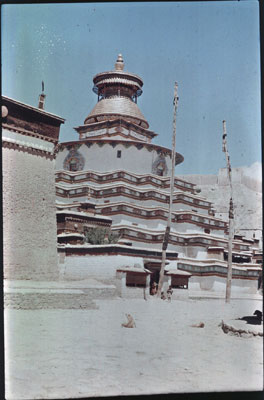
BMR.6.8.134 (Transparency colour)


BMR.6.8.134 (Transparency colour)

Hugh E. Richardson
Hugh Richardson
1936-50
Gyantse
BMR.6.8.134
60 x 90 mm
Transparency Colour
Hugh E. Richardson
Technical Information - The camera used to take this collection of colour slides (Dufay colour) were a Zeiss Super Ikonta and a Reflex Korelle. [KC 09/10/2006]
Manual Catalogues - Typewritten handlist entitled 'Hugh Richardson Collection, The British Museum. Photographs taken between 1936-50. Cameras: Zeiss Super Ikonta, Reflex Korelle. 300 colour slides (Dufay colour); copies made Jan. 1995.
[no.] 134. Gyantse Kumbum chorten.' [KC 10/10/2006]
Other Information - Setting: Gyurme Dorje writes in Tibet handbook, 1999 , Bath: Footprint Handbooks, p.260, "The great octagonal stupa of Gyantse - one of Tibet's outstanding artistic achievements, was built and decorated between 1427-39 by Prince Rabten Kunzang Phak in the style known as Tashi Gomang or Kumbum, which combines a terraced stupa exterior with multi-layered interior chapels. Rising 35 metres high, the stupas said to have 108 gates, nine storeys (including the base) and 75 chapels. ... Within the 75 chapels, the images form a progressive hierarchy of three dimensional mandalas, as outlined in the Sakyapa compilation known as the Drubtob Gyatsa, ensuring that the stupa encapsulates within it the entire spiritual path and gradation of the tantras." [KC 18/10/2006]
For Citation use:
The Tibet Album.
"Gyantse Kumbum"
05 Dec. 2006. The British Museum.
<http://tibet.prm.ox.ac.uk/photo_BMR.6.8.134.html>.
For more information about photographic usage or to order prints, please visit the The British Museum.
© The British Museum